8 Creative and Functional Chicken Coop Designs
- February 6, 2024
- 0 comment
Embarking on my role as a backyard chicken keeper, I’ve navigated the extensive array of chicken coop designs, each distinguished by its own distinctive style and practical features. This exploration into the realm of poultry housing has guided me to discover five exceptional chicken coop designs that masterfully merge inventive design with functional utility.
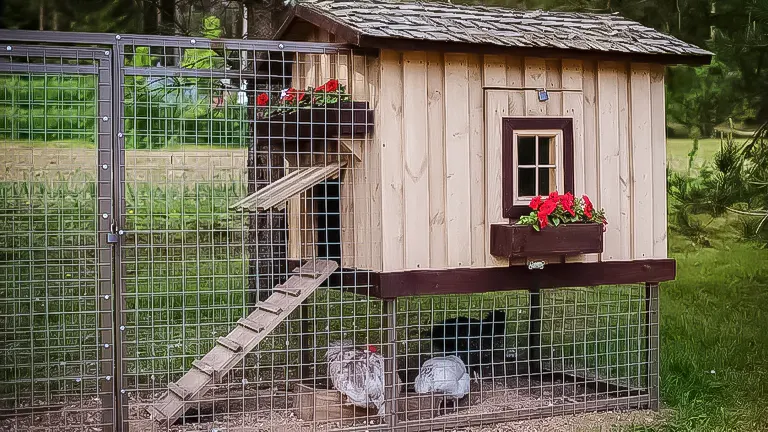
My assessment is based on personal experiences and an in-depth examination of the fundamental aspects of chicken care, including the provision of adequate space, ensuring safety, the simplicity of cleaning, proper ventilation, and ease of access.
List of 8 Creative and Functional Chicken Coop Designs
- Our Self Built Chicken Coop
- Country Cottage Style Chicken Coop
- Distinctive Chicken Coop in California
- A Compact Self Made Chicken Coop
- Charming Rustic Farmhouse Chicken Coop
- Compact Prefabricated Chicken Coop
- Eye Catching HGTV Chicken Coop
- Contemporary Chicken Coop Blueprints
Building the perfect chicken coop can be a complex task, but with the right inspiration, it’s achievable. I’ve curated a list of 18 innovative chicken coop ideas, drawn from our own experiences in designing a coop that meets both our needs and those of our chickens. This list is meant to inspire and guide you through designing or upgrading your coop.
Before starting, ensure you’re familiar with the basics of chicken coop requirements, which can be found in our “How To Build The Best Chicken Coop” guide. Use our ideas to detail every aspect of your coop’s design and functionality, creating a space that’s both practical for your chickens and suited to your lifestyle.
8 Exceptionally Inventive Chicken Coop Designs
1. Our Self-Built Chicken Coop
For Our Self-Built Chicken Coop, thorough research was key to achieving the ideal design. We aimed for simplicity without compromising functionality, exploring numerous ideas to ensure our coop met our specific needs.

Our goal was to accommodate 10-15 chickens comfortably, ensuring easy management, robust protection against cold weather and predators, and aesthetic harmony with our environment and main house. We chose a straightforward design with ample space, including storage for supplies, accessible nesting boxes, and a sizeable, roof-covered run area for year-round protection.
To fortify against predators, we buried the perimeter wire a foot deep, reinforcing it with concrete. A crucial design choice was ensuring the coop was tall enough to stand up in, enhancing our convenience and the overall usability of the space. The coop’s visual appeal was enhanced with a Pewter Green paint from Sherwin Williams, striking a balance between functionality and style.
2. Country Cottage Style Chicken Coop
This Country Cottage Style Chicken Coop from Twelve on Main shares many features with our own. It boasts a spacious, simple layout that includes ample headroom for standing upright inside, alongside doors tall enough to prevent any head-bumping incidents.
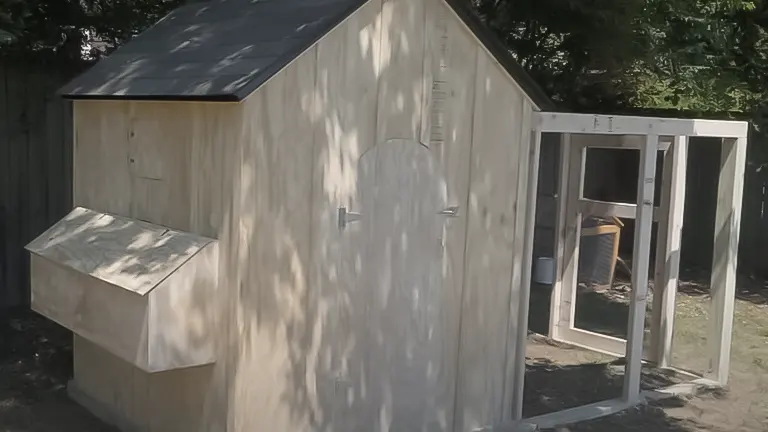
The design incorporates a large run area, mirroring the functionality and comfort we prioritize in our coop. Notably, this coop includes a generously sized storage section within its structure, offering enough room to store not only chicken-related supplies but also items for other animals.
Architecturally, the coop adopts a T-shape, with the run extending at a right angle from the main building, contributing to its distinctive farmhouse aesthetic. Enhancements such as a corrugated metal roof and a Dutch door, coupled with a clean, minimalistic white paint job, further accentuate its farmhouse charm.
Highlights We Admired:
In this chicken coop design, several features stood out to us:
- The Dutch door’s split opening is not only visually appealing but also enhances ventilation and deters unwelcome guests.
- The creative reuse of materials throughout the design.
- A strategically placed raised platform beneath the roosting bar efficiently collects droppings, simplifying the cleaning process.
- The installation of solar lights ensures an eco-friendly lighting solution that activates automatically in low light conditions.
- Thoughtfully positioned large windows, screened with wire, optimize sunlight exposure and provide essential ventilation, all while keeping the chickens secure.
- Conveniently accessible nesting boxes from the inside, allowing for streamlined care and maintenance.
3. Distinctive Chicken Coop in California
In California, a creative couple designed and constructed an exceptional chicken coop, selecting cedar wood for its natural durability and resilience as the primary material for the structure. To enhance its appearance and functionality, they incorporated clear panels and mesh into the walls, endowing the coop with a bright, airy ambiance reminiscent of a greenhouse.
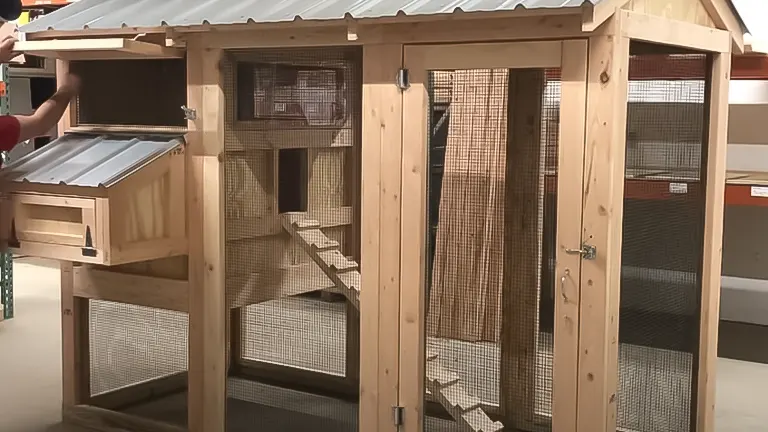
Additional innovative chicken coop features from this inventive couple include:
- Integrating plants to enhance the coop’s appeal, with grapevines winding up the structure and herbs planted along the edges.
- Selecting cedar for its inherent properties, including resistance to decay, insects, and warping.
- Opting for a particular type of gravel, specifically Hanley Gold, chosen for its attractive color.
- Creating a spacious fenced area for free-ranging, alongside a sheltered run.
- Incorporating clear wall panels to keep the structure visually unobtrusive.
4. A Compact Self-Made Chicken Coop
For those contemplating a smaller yet aesthetically pleasing chicken coop, the design by Woodshop Mike could be an ideal choice. Crafted offsite in a well-equipped professional workshop utilizing numerous power tools, this model, however, remains straightforward enough for a personal DIY project.

Its compact size incorporates an external nesting box, optimizing interior space while simplifying egg collection. The design features an eye-catching arched door and roof shingles that lend it the charming appearance of a miniature house. One practical advantage of its modest dimensions is the ease of installing roof shingles at ground level before attaching them overhead.
A valuable tip highlighted in this project is the importance of preventing accidental lock-ins within the coop, often a risk with gate latch doors. Solutions include using a block of wood to keep the door ajar or a wire mechanism for opening the latch from inside, though these methods require caution to prevent the chickens from escaping.
5. Charming Rustic Farmhouse Chicken Coop
The rustic chicken coop crafted by Cottonwood Shanty beautifully demonstrates how upcycling and repurposing materials can result in a design that doesn’t compromise on aesthetics. The heart of its rustic farmhouse allure lies in the inventive use of old doors and natural elements.
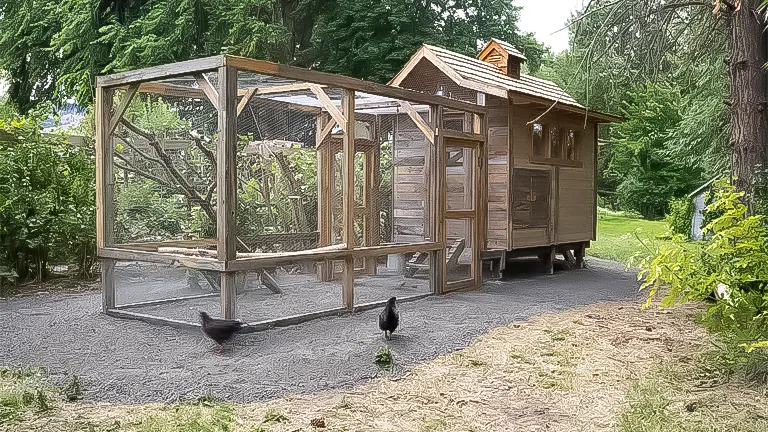
An old screen door finds new life as the entrance to the run, while a weathered, aged door enhances the coop’s entrance, contributing to its timeworn charm. The incorporation of a long tree branch as a roosting bar reinforces the connection to nature and the rustic theme.
A creative and practical tip from this design is the integration of plants within the run area, specifically choosing varieties that chickens are less likely to consume, adding greenery without sacrificing utility.
The exterior is thoughtfully adorned with wall lights and plants by the entrance, lending a cozy, inviting look to the coop, indicative of the contentment of its feathered inhabitants.
6. Compact Prefabricated Chicken Coop
For those who prefer the convenience of a prefabricated kit and are working with limited outdoor space, the ingeniously structured chicken coop kit from Williams Sonoma could be the ideal solution. It features an innovative addition of a built-in planter box, enhancing its functionality and aesthetic appeal.
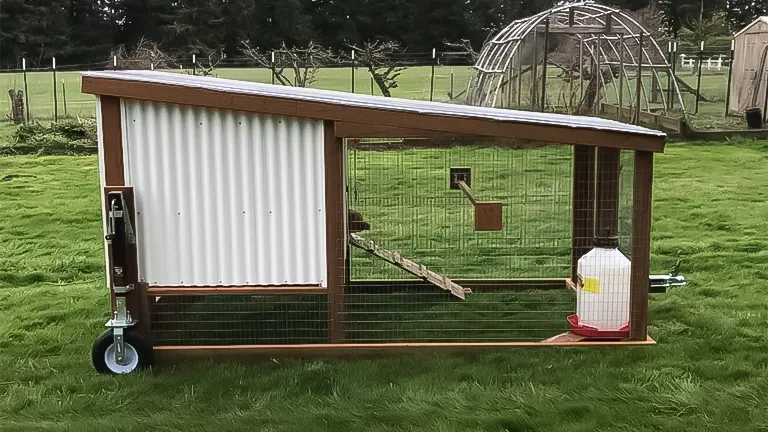
The design ingeniously maximizes space by situating the run directly beneath the coop, resulting in a minimal footprint. While its compact size means it’s best suited for housing approximately 4 chickens, it’s a perfect match for those whose space constraints limit their flock size.
Regardless of whether this specific chicken coop fits your needs, the principles of its space-saving design and the integration of a planter box offer valuable inspiration for incorporating into your chicken coop projects.
7. Eye-Catching HGTV Chicken Coop
What immediately captures attention with this HGTV-designed chicken coop is its vibrant, deep red hue set against crisp white accents. This choice of color scheme demonstrates the significant impact that color can have on enhancing a chicken coop’s appearance.
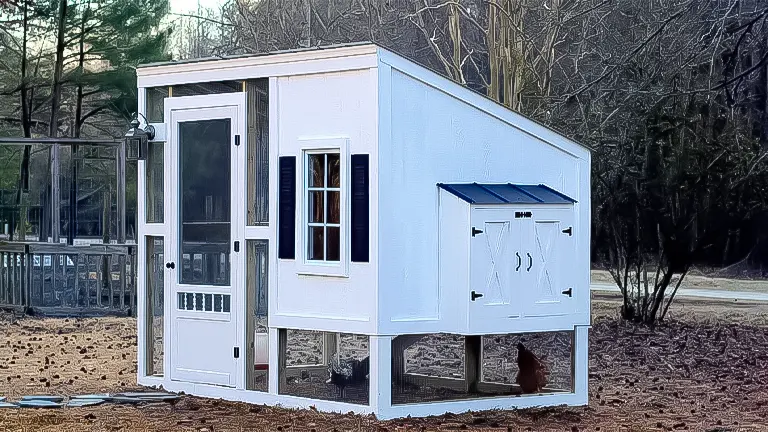
The design features a smart, compact layout where the chicken run is partially positioned underneath the henhouse, optimizing space. Additionally, it includes an external nesting box for easy egg collection and is adorned with a charming flower box situated beneath the window, adding a touch of beauty and functionality.
This design showcases how strategic color choices and thoughtful design elements can elevate a chicken coop from purely functional to aesthetically pleasing.
8. Contemporary Chicken Coop Blueprints
Shifting gears from quaint traditionalism to the cutting edge of modernity, we explore a chicken coop that boasts an architecturally modern design. This standout creation diverges markedly from conventional coop concepts, offering a fresh perspective that could seamlessly integrate with your property’s aesthetic.
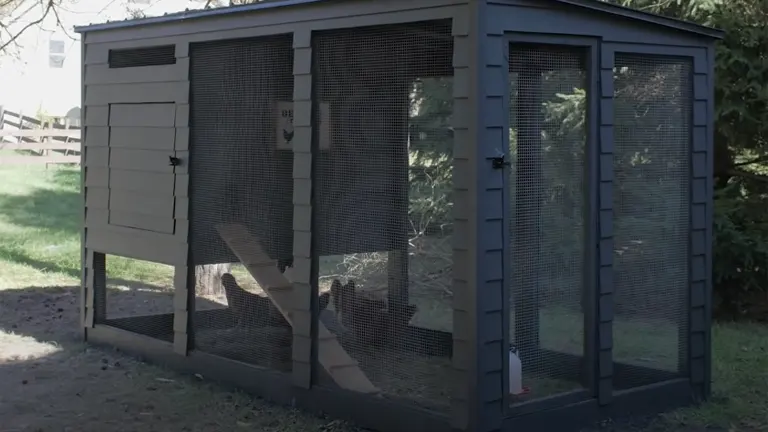
The coop’s wall construction features an innovative slatted design, promoting airflow and creating a pleasant balance of sunlight and shadow for the chickens’ comfort.
Imagining this structure adjacent to a contemporary home, especially in warmer climates, it’s clear how well the coop’s design could complement modern architectural styles while providing ample shade for the chickens under the harsh sun.
This modern approach to chicken coop design marries functionality with architectural beauty, making it a striking addition to any property looking to blend utility with contemporary style.
All-In-All Final Thoughts
Exploring these eight creative and functional chicken coop designs reveals a diverse range of possibilities for backyard poultry enthusiasts. From the rustic charm of upcycled materials to the sleek lines of modern architecture, each design offers unique features such as built-in planter boxes, space-efficient layouts, and innovative ventilation systems.
These coops not only cater to the practical needs of keeping chickens safe and comfortable but also enhance the aesthetic appeal of outdoor spaces. Whether you’re drawn to the simplicity of a DIY kit or the sophistication of an architect-designed structure, these ideas demonstrate that with a bit of creativity and planning, you can create a chicken coop that is both a functional home for your chickens and a beautiful addition to your property.
Related Articles:
- Best Bedding For Chickens
- Best Safe Chicken Coop Heater
- 8×8 Chicken Coop Plans
- Turning a Shed Into a Chicken Coop
- How to Make a Chicken Coop Out of Pallets
- Best Sand for Chicken Coop
- How To Insulate a Chicken Coop
- How To Heat a Chicken Coop
- How To Keep Water from Freezing in Chicken Coop
- How to Build a Chicken Coop
- How To Build Chicken Nesting Boxes
Frequently Asked Questions
- What are the key features to look for in a creative chicken coop design?
Look for designs that offer good ventilation, ample natural light, easy access for cleaning, predator-proofing, and sufficient space per chicken. Creative elements might include unique use of materials, architectural styles, or integrated garden features. - How much space do I need for a chicken coop?
A general rule is to provide at least 3-4 square feet of coop space per chicken inside and about 8-10 square feet per chicken in an outdoor run. However, more space is always better for the chickens’ health and happiness. - Can I integrate a garden with my chicken coop design?
Yes, many creative designs incorporate gardens, either through a green roof, surrounding the coop with edible plants, or using a chicken tractor to allow chickens to graze and fertilize different sections of your garden. - What materials are best for building a chicken coop?
Durable, weather-resistant materials like cedar wood are great for coops. Recycled materials can also be used creatively, but ensure they are safe and non-toxic for chickens. - How do I ensure my chicken coop is predator-proof?
Use hardware cloth instead of chicken wire for better protection, secure all doors and windows with locks, and consider a buried wire perimeter or an apron to prevent digging predators. - What is the importance of ventilation in chicken coop design?
Proper ventilation prevents moisture build-up, which can lead to respiratory issues and diseases in chickens. It helps maintain a healthy air quality and temperature regulation inside the coop. - How can I make my chicken coop easy to clean?
Designs with removable droppings trays, large access doors, and materials that can be easily hosed down or swept make cleaning simpler and more efficient. - What are some creative ways to ensure sufficient lighting in my chicken coop?
Solar-powered lights, large windows positioned to capture sunlight, and light-colored interior walls to reflect natural light can all contribute to a well-lit coop. - Can chicken coops be mobile, and what are the benefits?
Yes, chicken tractors or mobile coops allow you to move your chickens around your yard, giving them access to fresh ground while keeping them protected. Benefits include natural pest control and evenly distributed manure. - How can I customize a prefab chicken coop kit to make it more functional and unique?
Add external nesting boxes for easier egg collection, incorporate a rainwater collection system, paint it to match your house, or add decorative elements like trim or flower boxes to enhance its appearance.
We’re eager to hear your feedback! Please share your personal experiences and insights about the 8 Creative and Functional Chicken Coop Designs in the comments section below. Your unique perspective could greatly assist fellow enthusiasts in crafting or enhancing their own chicken coops with informed and inspired decisions!

Edward Smith
Forestry AuthorWoodworking is about more than crafting; it's a harmonious connection with nature, mastering tools, and preserving our environment. I'm here to share my knowledge and experiences with you, forging a future where we can embrace wood's beauty and utility while safeguarding our forests' health and diversity.













Leave your comment